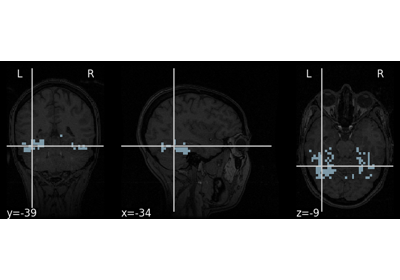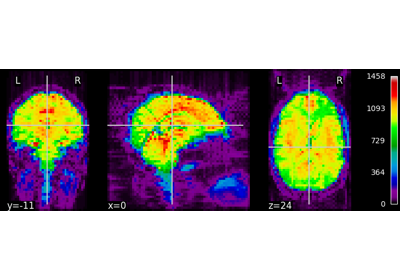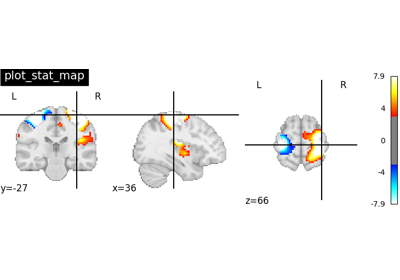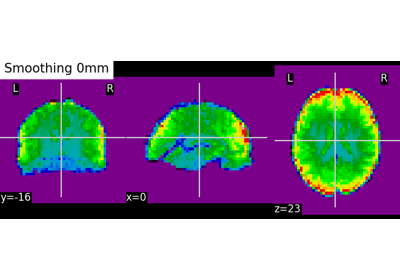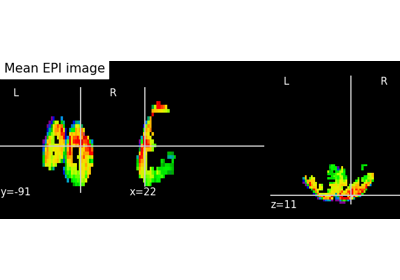Note
This page is a reference documentation. It only explains the function signature, and not how to use it. Please refer to the user guide for the big picture.
nilearn.plotting.plot_epi#
- nilearn.plotting.plot_epi(epi_img=None, cut_coords=None, output_file=None, display_mode='ortho', figure=None, axes=None, title=None, annotate=True, draw_cross=True, black_bg=True, colorbar=False, cbar_tick_format='%.2g', cmap=<matplotlib.colors.LinearSegmentedColormap object>, vmin=None, vmax=None, **kwargs)[source]#
Plot cuts of an EPI image (by default 3 cuts: Frontal, Axial, and Lateral)
- Parameters
- epi_imga nifti-image like object or a filename, optional
The EPI (T2*) image.
- cut_coordsNone, a
tupleoffloat, orint, optional The MNI coordinates of the point where the cut is performed.
If
display_modeis ‘ortho’ or ‘tiled’, this should be a 3-tuple:(x, y, z)For
display_mode == 'x', ‘y’, or ‘z’, then these are the coordinates of each cut in the corresponding direction.If
Noneis given, the cuts are calculated automatically.If
display_modeis ‘mosaic’, and the number of cuts is the same for all directions,cut_coordscan be specified as an integer. It can also be a length 3 tuple specifying the number of cuts for every direction if these are different.
Note
If
display_modeis ‘x’, ‘y’ or ‘z’,cut_coordscan be an integer, in which case it specifies the number of cuts to perform.- output_file
str, or None, optional The name of an image file to export the plot to. Valid extensions are .png, .pdf, .svg. If
output_fileis not None, the plot is saved to a file, and the display is closed.- display_mode{‘ortho’, ‘tiled’, ‘mosaic’,’x’,’y’, ‘z’, ‘yx’, ‘xz’, ‘yz’}, optional
Choose the direction of the cuts:
‘x’: sagital
‘y’: coronal
‘z’: axial
‘ortho’: three cuts are performed in orthogonal directions
‘tiled’: three cuts are performed and arranged in a 2x2 grid
‘mosaic’: three cuts are performed along multiple rows and columns
Default=’ortho’.
- figure
int, ormatplotlib.figure.Figure, or None, optional Matplotlib figure used or its number. If
Noneis given, a new figure is created.- axes
matplotlib.axes.Axes, or 4 tupleoffloat: (xmin, ymin, width, height), optional The axes, or the coordinates, in matplotlib figure space, of the axes used to display the plot. If
None, the complete figure is used.- title
str, or None, optional The title displayed on the figure. Default=None.
- annotate
bool, optional If
annotateisTrue, positions and left/right annotation are added to the plot. Default=True.- draw_cross
bool, optional If
draw_crossisTrue, a cross is drawn on the plot to indicate the cut position. Default=True.- black_bg
bool, or ‘auto’, optional If
True, the background of the image is set to be black. If you wish to save figures with a black background, you will need to pass facecolor=’k’, edgecolor=’k’ tomatplotlib.pyplot.savefig. Default=True.- colorbarboolean, optional
If True, display a colorbar on the right of the plots. Default=False.
- cbar_tick_format: str, optional
Controls how to format the tick labels of the colorbar. Ex: use “%i” to display as integers. Default is ‘%.2g’ for scientific notation.
- cmap
matplotlib.colors.Colormap, orstr, optional The colormap to use. Either a string which is a name of a matplotlib colormap, or a matplotlib colormap object. Default=`plt.cm.nipy_spectral`.
- vmin
float, optional Lower bound of the colormap. If
None, the min of the image is used. Passed tomatplotlib.pyplot.imshow.- vmax
float, optional Upper bound of the colormap. If
None, the max of the image is used. Passed tomatplotlib.pyplot.imshow.
Notes
Arrays should be passed in numpy convention: (x, y, z) ordered.
Examples using nilearn.plotting.plot_epi#
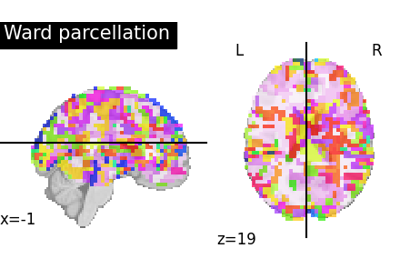
Clustering methods to learn a brain parcellation from fMRI
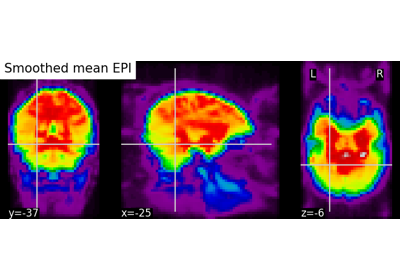
Computing a Region of Interest (ROI) mask manually
